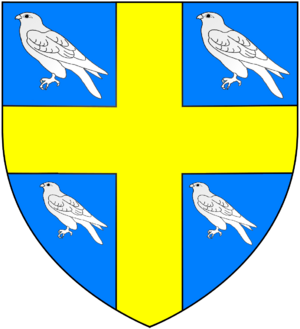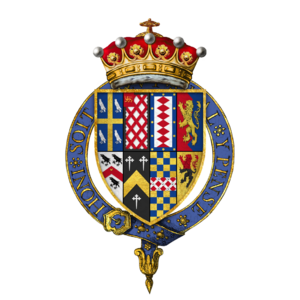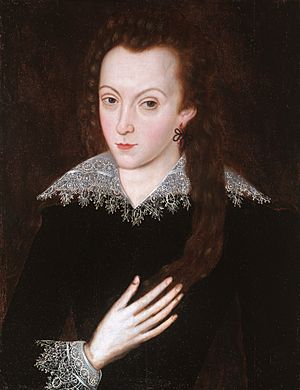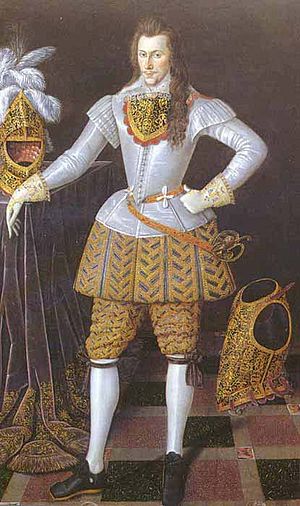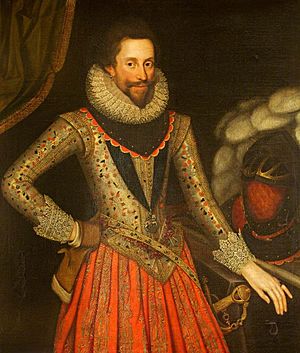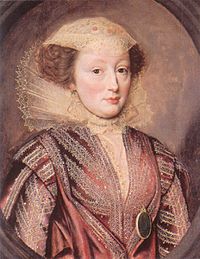Henry Wriothesley, 3rd Earl of Southampton facts for kids
Quick facts for kids Henry Wriothesley, 3rd Earl of Southampton |
|
|---|---|
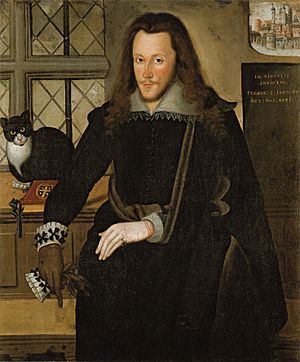 |
|
| Henry Wriothesley, 3rd Earl of Southampton, in the Tower of London in 1603, at age 30; painting attributed to John de Critz. A small painting of the Tower of London is shown in the top-right background, above the Latin words: In vinculis invictus ("in chains unconquered") February 8, 1600; 601; 602; 603 April. The arms of Wriothesley (Azure, a cross or between four hawks close argent) are shown on the cover of a book lying on the windowsill in front of the cat. | |
| Spouse(s) | Elizabeth Vernon (m. 1598) |
| Issue | |
| Penelope Wriothesley James Wriothesley, Lord Wriothesley Thomas Wriothesley, 4th Earl of Southampton Anne Wriothesley |
|
| Father | Henry Wriothesley, 2nd Earl of Southampton |
| Mother | Mary Browne |
| Born | 6 October 1573 Cowdray House, Sussex, England |
| Died | 10 November 1624 (aged 51) Bergen op Zoom, Dutch Republic |
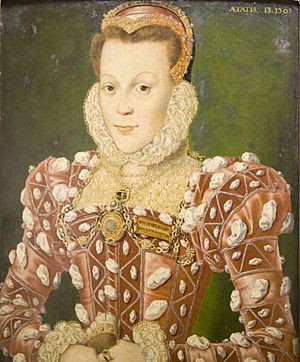
Henry Wriothesley, 3rd Earl of Southampton (born 6 October 1573 – died 10 November 1624) was an important English nobleman. He was the only son of Henry Wriothesley, 2nd Earl of Southampton and Mary Browne.
He is best known for his connection to William Shakespeare. Shakespeare dedicated two of his long poems, Venus and Adonis and The ... of Lucrece, to Southampton. Many people also believe that Southampton was the "Fair Youth" mentioned in Shakespeare's Sonnets.
Contents
Family and Early Life
Henry Wriothesley was born on 6 October 1573 at Cowdray House in Sussex, England. His father was the 2nd Earl of Southampton. His mother, Mary Browne, was the daughter of Anthony Browne, 1st Viscount Montagu. Henry had two sisters, Jane and Mary.
When Henry's father died in 1581, Henry became the 3rd Earl of Southampton. He was only eight years old. The Queen sold the right to look after him and arrange his marriage to Charles Howard, 1st Earl of Nottingham. Later, this right was given to William Cecil, 1st Baron Burghley, a powerful advisor to Queen Elizabeth I.
In 1581 or 1582, young Henry moved to live with Lord Burghley in London. In October 1585, at age 12, he started studying at St John's College, Cambridge. He earned his master's degree in 1589.
Lord Burghley tried to arrange a marriage for Henry with his granddaughter, Elizabeth Vere. However, Henry did not want to marry her. In 1594, when Henry was 21, it was rumored he paid a large fine to avoid the marriage.
Southampton and William Shakespeare
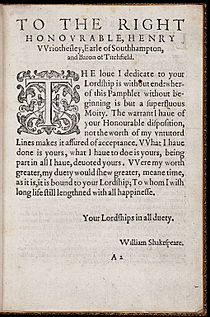
In 1593, William Shakespeare dedicated his poem Venus and Adonis to Southampton. The next year, he dedicated The ... of Lucrece to him as well. The dedication for The ... of Lucrece was very praising. Shakespeare wrote that his love for Southampton was "without end."
This kind of strong language was common back then. Writers often praised noble people who supported their work. This support was important for money and political reasons.
Some scholars believe Southampton was the "Fair Youth" in Shakespeare's famous Sonnets. These poems are addressed to a handsome young man. Even though many researchers have looked, no other documents have been found about their friendship besides these dedications.
Life in the 1590s
Southampton was a popular figure and received dedications from other writers too. These writers included Thomas Nashe and John Florio. Florio, who worked for Southampton, praised his excellent Italian language skills.
In 1598, Southampton had a fight at court with Ambrose Willoughby. The Queen was not pleased and briefly banned Southampton from court. This argument might have been about something Willoughby said that caused trouble between Southampton and his girlfriend, Elizabeth Vernon. Elizabeth was one of the Queen's ladies-in-waiting.
Southampton decided to travel abroad. He went with Robert Cecil, 1st Earl of Salisbury on a trip to France. While in France, he secretly returned to England and married Elizabeth Vernon. She was expecting their child. The Queen was very angry because they married without her permission. Elizabeth Vernon was briefly sent to jail. Southampton also returned to England and was jailed for a month. Their daughter, Penelope, was born during this time.
In 1599, Southampton went to Ireland with the Earl of Essex during the Nine Years' War. He was made General of the Horse, but the Queen canceled this appointment. Southampton still stayed with Essex and helped in battles.
After returning from Ireland, Southampton spent a lot of time watching plays in London. He was known for going to plays almost every day.
Southampton was involved in Essex's Rebellion in 1601. This was a plan to overthrow Queen Elizabeth I. He was sentenced to death for his part in it. However, his sentence was changed to life imprisonment.
Life Under King James I
When King James I became king in 1603, Southampton was released from prison. He received many honors from the new king. He also continued his connection with the theater. In 1605, he hosted a performance of Shakespeare's play Love's Labour's Lost for Queen Anne.
Southampton was known for being a fighter. He was briefly jailed again in 1603 after a heated argument in front of Queen Anne. He also strongly opposed George Villiers, 1st Duke of Buckingham in 1621.
He was a leader among noblemen who invested in new businesses. He helped start a tinplate mill and an ironworks. He also developed his properties in London. He supported the British East India Company and the New England Company. He even backed Henry Hudson's search for the Northwest Passage.
Southampton also supported many artists and composers. He helped promote the work of writers like George Chapman and Thomas Heywood.
Virginia Company
Henry Wriothesley played a big part in promoting the English colonies in America. He was an active member of the Virginia Company, which aimed to establish the Jamestown colony.
Southampton and his group wanted to create a lasting colony. They hoped it would expand British land, help with England's growing population, and create new markets for English goods. Even though the Virginia Company did not make much money and closed in 1624, these other goals were achieved.
Many people believe that places like Hampton Roads, Hampton, Virginia, and Southampton County, Virginia were named after him.
Later Life and Death
In 1624, Southampton was chosen to lead English troops fighting against the Spanish in the Low Countries. Shortly after they arrived, his oldest son, James Wriothesley, Lord Wriothesley, died of a fever. Five days later, on 10 November 1624, Southampton also died of the same fever. He was 51 years old.
Their bodies were brought back to England. Both were buried in the family chapel in Titchfield, Hampshire.
Southampton is mostly remembered today as a supporter of William Shakespeare.
His second son, Thomas Wriothesley, became the 4th Earl. He later became a very important statesman.
Marriage and Children
In August 1598, Southampton married Elizabeth Vernon. She was the daughter of John Vernon and Elizabeth Devereux. Elizabeth Devereux was the aunt of the Earl of Essex.
Their marriage was kept secret at first. Queen Elizabeth was angry because her ladies-in-waiting needed her permission to marry. Both Henry and Elizabeth were briefly sent to jail for this.
Henry and Elizabeth had two sons and three daughters:
- Lady Penelope Wriothesley (born 1598 – died 1667)
- Lady Anne Wriothesley (born 1600 – died 1662)
- James Wriothesley, Lord Wriothesley (born 1605 – died 1624), who died of a fever while fighting in the Low Countries.
- Thomas Wriothesley (born 1607 – died 1667), who became the 4th Earl of Southampton.
Portraits
Many portraits of Southampton exist. They show him with dark reddish-brown hair and blue eyes. This matches Shakespeare's description of him as "a man right fair."
In 2002, a portrait in the Cobbe collection was identified as a painting of the young Earl. It shows him as a youthful person and is now known as the Cobbe portrait of Southampton.
In 2008, another portrait believed to be of Southampton was found. It was hidden underneath a painting of his wife, Elizabeth Vernon, when the artwork was X-rayed.


